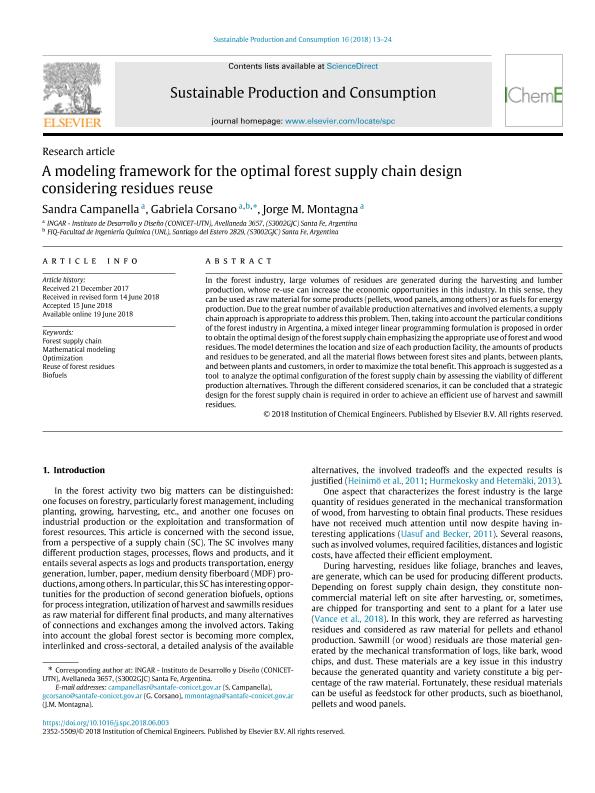Mostrar el registro sencillo del ítem
dc.contributor.author
Campanella, Sandra Romina

dc.contributor.author
Corsano, Gabriela

dc.contributor.author
Montagna, Jorge Marcelo

dc.date.available
2019-10-23T01:01:47Z
dc.date.issued
2018-10
dc.identifier.citation
Campanella, Sandra Romina; Corsano, Gabriela; Montagna, Jorge Marcelo; A modeling framework for the optimal forest supply chain design considering residues reuse; Elsevier B.V.; Sustainable Production and Consumption; 16; 10-2018; 13-24
dc.identifier.issn
2352-5509
dc.identifier.uri
http://hdl.handle.net/11336/87034
dc.description.abstract
In the forest industry, large volumes of residues are generated during the harvesting and lumber production, whose re-use can increase the economic opportunities in this industry. In this sense, they can be used as raw material for some products (pellets, wood panels, among others) or as fuels for energy production. Due to the great number of available production alternatives and involved elements, a supply chain approach is appropriate to address this problem. Then, taking into account the particular conditions of the forest industry in Argentina, a mixed integer linear programming formulation is proposed in order to obtain the optimal design of the forest supply chain emphasizing the appropriate use of forest and wood residues. The model determines the location and size of each production facility, the amounts of products and residues to be generated, and all the material flows between forest sites and plants, between plants, and between plants and customers, in order to maximize the total benefit. This approach is suggested as a tool to analyze the optimal configuration of the forest supply chain by assessing the viability of different production alternatives. Through the different considered scenarios, it can be concluded that a strategic design for the forest supply chain is required in order to achieve an efficient use of harvest and sawmill residues.
dc.format
application/pdf
dc.language.iso
eng
dc.publisher
Elsevier B.V.
dc.rights
info:eu-repo/semantics/openAccess
dc.rights.uri
https://creativecommons.org/licenses/by-nc-sa/2.5/ar/
dc.subject
BIOFUELS
dc.subject
FOREST SUPPLY CHAIN
dc.subject
MATHEMATICAL MODELING
dc.subject
OPTIMIZATION
dc.subject
REUSE OF FOREST RESIDUES
dc.subject.classification
Otras Ingenierías y Tecnologías

dc.subject.classification
Otras Ingenierías y Tecnologías

dc.subject.classification
INGENIERÍAS Y TECNOLOGÍAS

dc.title
A modeling framework for the optimal forest supply chain design considering residues reuse
dc.type
info:eu-repo/semantics/article
dc.type
info:ar-repo/semantics/artículo
dc.type
info:eu-repo/semantics/publishedVersion
dc.date.updated
2019-10-22T17:56:44Z
dc.journal.volume
16
dc.journal.pagination
13-24
dc.journal.pais
Reino Unido

dc.description.fil
Fil: Campanella, Sandra Romina. Consejo Nacional de Investigaciones Científicas y Técnicas. Centro Científico Tecnológico Conicet - Santa Fe. Instituto de Desarrollo y Diseño. Universidad Tecnológica Nacional. Facultad Regional Santa Fe. Instituto de Desarrollo y Diseño; Argentina
dc.description.fil
Fil: Corsano, Gabriela. Consejo Nacional de Investigaciones Científicas y Técnicas. Centro Científico Tecnológico Conicet - Santa Fe. Instituto de Desarrollo y Diseño. Universidad Tecnológica Nacional. Facultad Regional Santa Fe. Instituto de Desarrollo y Diseño; Argentina
dc.description.fil
Fil: Montagna, Jorge Marcelo. Consejo Nacional de Investigaciones Científicas y Técnicas. Centro Científico Tecnológico Conicet - Santa Fe. Instituto de Desarrollo y Diseño. Universidad Tecnológica Nacional. Facultad Regional Santa Fe. Instituto de Desarrollo y Diseño; Argentina
dc.journal.title
Sustainable Production and Consumption
dc.relation.alternativeid
info:eu-repo/semantics/altIdentifier/doi/http://dx.doi.org/10.1016/j.spc.2018.06.003
Archivos asociados
